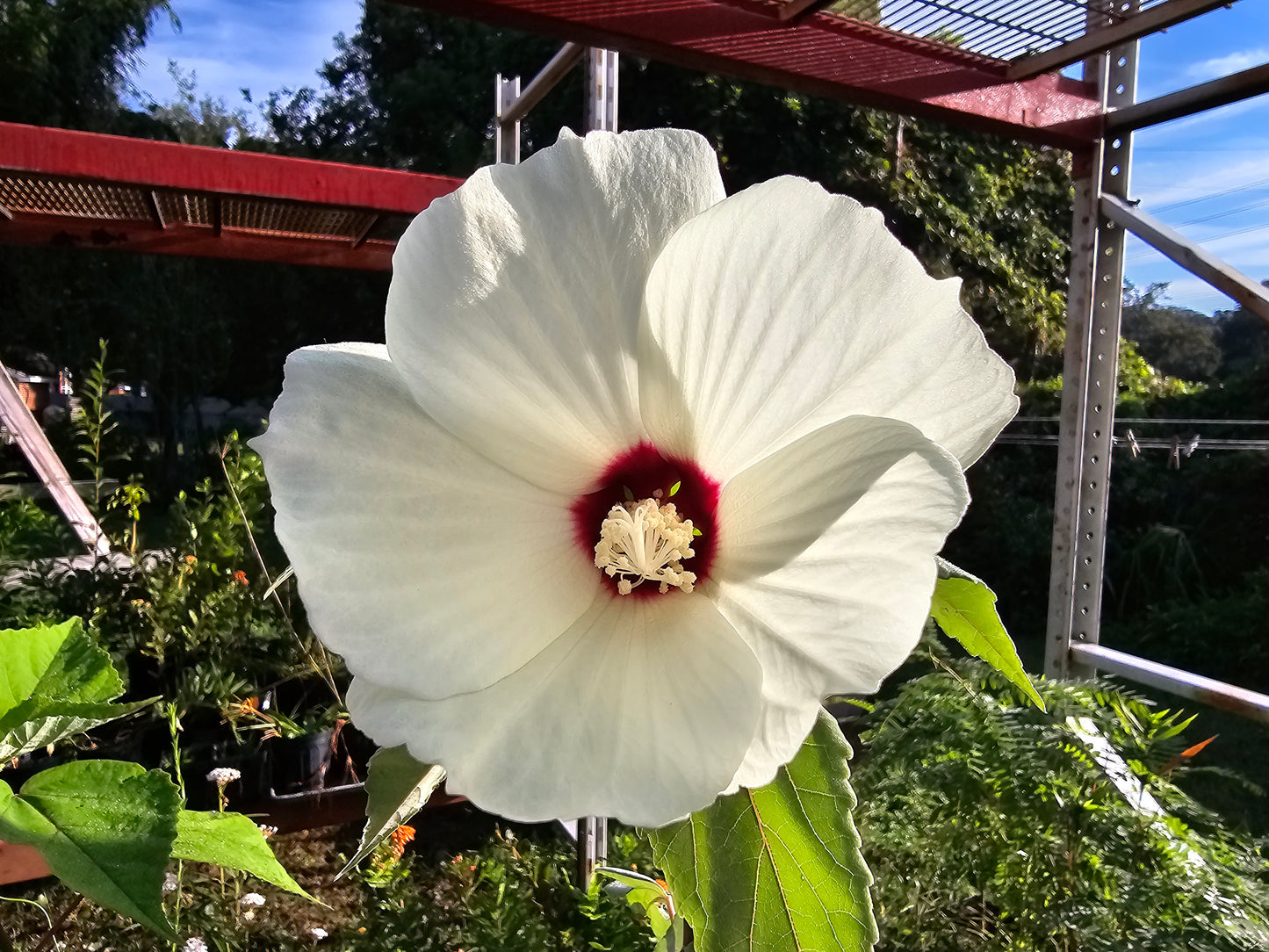Gnarly Nursery
Hibiscus moscheutos, Crimson-eyed Rose-mallow
Hibiscus moscheutos, Crimson-eyed Rose-mallow
Out of stock
Couldn't load pickup availability
Hibiscus moscheutos
Synonym(s)
(Hibiscus palustris)
Common Name(s)
Crimson-eyed Rose-mallow, Swamp Rose-mallow, Wild Cotton
- Phonetic Spelling
- hy-BIS-kus mos-KEW-tus
- Description
- Rose Mallow is a tall, shrub-like, woody-based herbaceous perennial in the Malvaceae or mallow family. It has huge hollyhock-like flowers in shades of white, pink, red, or burgundy that blooms from midsummer to early fall. The flowers measure up to 8 inches in diameter and have spreading petals with a contrasting central eye of red or burgundy and protruding staminal column that is creamy white to pale yellow. The leaves are alternate, ovate to lanceolate, green to greenish-gray on the upper surface, and the undersides are white and hairy. The plant grows upright from to 2 to 6 feet tall and 2 to 5 feet wide and has multiple sturdy stems. The flowers are replaced by seed capsules.
Rose Mallow is native to wetlands, creek edges and roadside ditches in the southeastern United States and is found in the northern half of Florida.
This plant prefers full to partial sun and wet to constantly moist soils containing loam, silt, or some sand with organic material and a slightly acidic pH. In full sun, the plant has better bloom production and is more disease resistant. This plant is heat, humidity, and wet soil tolerant, and it is slightly salt tolerant. Plant in a protected area to prevent wind damage, and be sure to provide good air circulation. Pinching back the growing tips will encourage the plant to be more bush-like, and deadheading the spent flowers will improve the plant's appearance. The individual flowers are short-lived, but the blooming period generally lasts about 1 month. Cut back the stems nearly to ground level in the fall. Propagation is through seeds, stem cutcuttingsr division.
Use Rose Mallow in the lowest area of the garden, as a specimen, along streams or ponds, or as a temporary summer screen or hedge. Plant in native, pollinator, butterfly, or rain gardens. It can also be grown in large containers. Its saucer-shaped flowers are a wildlife food source and are an attractant for pollinators, hummingbirds, butterflies, and specialized bees.
- Family
- Malvaceae
- Native Range
- Southeastern Canada--Ontario, Northeast Mexico, and the United States. The plants I carry are from NE Florida populations.
- Hardiness Zone(s)
- 4a --to-- 9b
- Lifespan
- Deciduous, Herbaceous, Long-lived, Perennial
- Habitats
- Marshes and stream edges
- Exposure
- Sun
- Growth Habit
- Erect and multi-stemmed, 2-6 ft tall by 2-4 ft wide
- Soil Texture
- Organic (Humus), Organic (Muck), Loam (Sand/Silt/Clay), Deep Sand
- Propagation
- --Seeds
--Division
--Herbaceous Stem Cuttings are made from nonwoody, herbaceous plants. - Moisture
- Stays Wet --to-- Not wet but not extremely dry
- Salt Water Tolerance
- Tolerant of inundation with brackish water.
- Salt Spray Tolerance
- Some tolerance to salty wind but not direct salt spray.
- Attracts
- Butterflies, Hummingbirds, Pollinators, Specialized Bees
- Recommended Uses
- Fall Color, Native Planting, Pollinator Gardens, Water Garden
- Pot Size
- 6" (trade gallon) pot (about 3 qt)
Share



